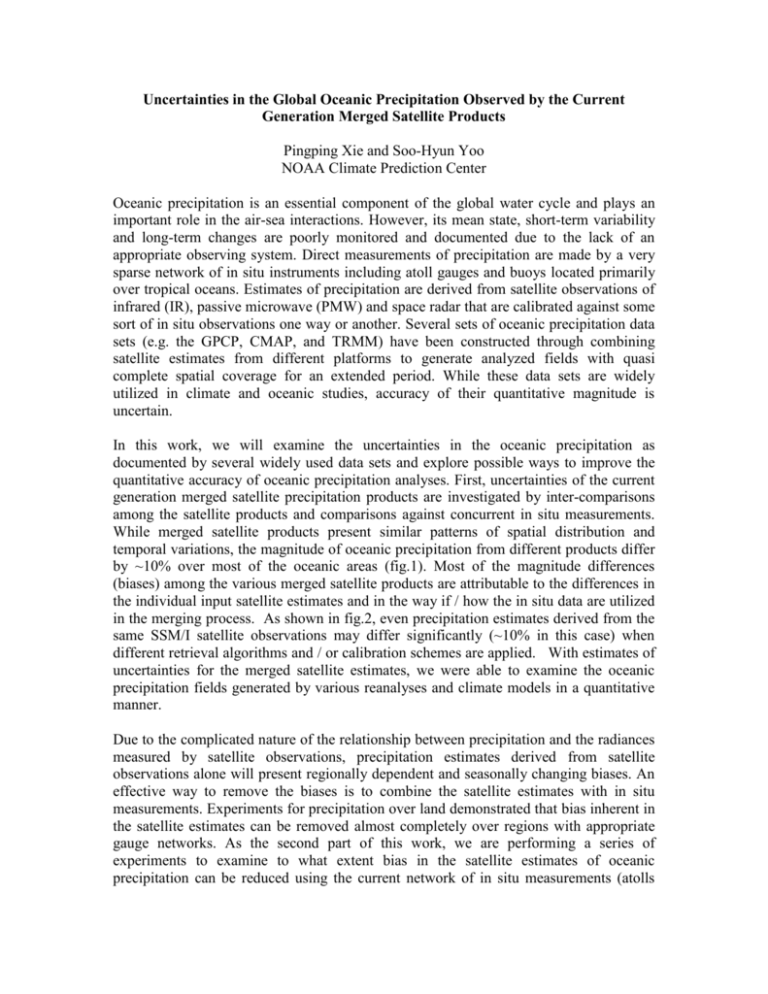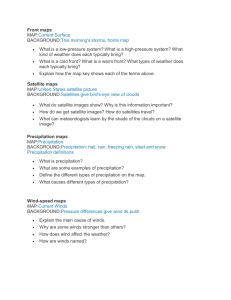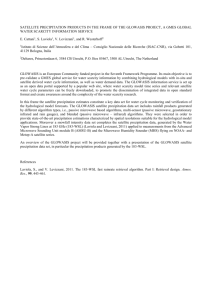Marine Stratus and Its Relationship to Regional and
advertisement

Uncertainties in the Global Oceanic Precipitation Observed by the Current Generation Merged Satellite Products Pingping Xie and Soo-Hyun Yoo NOAA Climate Prediction Center Oceanic precipitation is an essential component of the global water cycle and plays an important role in the air-sea interactions. However, its mean state, short-term variability and long-term changes are poorly monitored and documented due to the lack of an appropriate observing system. Direct measurements of precipitation are made by a very sparse network of in situ instruments including atoll gauges and buoys located primarily over tropical oceans. Estimates of precipitation are derived from satellite observations of infrared (IR), passive microwave (PMW) and space radar that are calibrated against some sort of in situ observations one way or another. Several sets of oceanic precipitation data sets (e.g. the GPCP, CMAP, and TRMM) have been constructed through combining satellite estimates from different platforms to generate analyzed fields with quasi complete spatial coverage for an extended period. While these data sets are widely utilized in climate and oceanic studies, accuracy of their quantitative magnitude is uncertain. In this work, we will examine the uncertainties in the oceanic precipitation as documented by several widely used data sets and explore possible ways to improve the quantitative accuracy of oceanic precipitation analyses. First, uncertainties of the current generation merged satellite precipitation products are investigated by inter-comparisons among the satellite products and comparisons against concurrent in situ measurements. While merged satellite products present similar patterns of spatial distribution and temporal variations, the magnitude of oceanic precipitation from different products differ by ~10% over most of the oceanic areas (fig.1). Most of the magnitude differences (biases) among the various merged satellite products are attributable to the differences in the individual input satellite estimates and in the way if / how the in situ data are utilized in the merging process. As shown in fig.2, even precipitation estimates derived from the same SSM/I satellite observations may differ significantly (~10% in this case) when different retrieval algorithms and / or calibration schemes are applied. With estimates of uncertainties for the merged satellite estimates, we were able to examine the oceanic precipitation fields generated by various reanalyses and climate models in a quantitative manner. Due to the complicated nature of the relationship between precipitation and the radiances measured by satellite observations, precipitation estimates derived from satellite observations alone will present regionally dependent and seasonally changing biases. An effective way to remove the biases is to combine the satellite estimates with in situ measurements. Experiments for precipitation over land demonstrated that bias inherent in the satellite estimates can be removed almost completely over regions with appropriate gauge networks. As the second part of this work, we are performing a series of experiments to examine to what extent bias in the satellite estimates of oceanic precipitation can be reduced using the current network of in situ measurements (atolls and tropical buoys) and how the configuration of the in situ network has to be to provide appropriate reference of ‘ground truth’ of precipitation over various parts of the global oceans. Detailed results will be reported at the conference. Fig. 1: Global distribution of the mean (upper) and standard deviation (middle) of the mean annual precipitation (mm/day) from the GPCP, CMAP and TRMM merged precipitation. The bottom panel shows the latitudinal profile of the mean annual precipitation averaged from the three data sets (black line) and the standard deviation among them (blue shading). Fig. 2: SSM/I-based precipitation estimates for July 2006, derived from two different algorithms (upper and middle) and their differences (mm/day, bottom).






